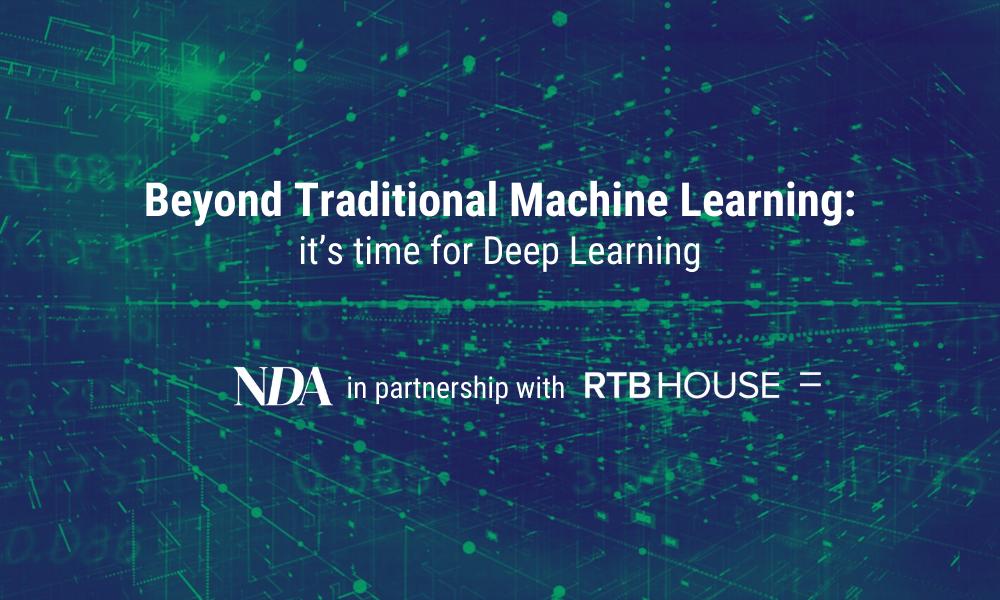by Łukasz Włodarczyk, VP of Programmatic Ecosystem Growth & Innovation, RTB House
In my work with RTB House, one of the most common questions I encounter is: what is the difference between AI, ‘classic’ Machine Learning, and the cutting-edge Deep Learning technology that RTB’s demand side platform (DSP) depends on?
As the digital landscape continues to evolve rapidly, it’s becoming increasingly important for marketers to understand the distinction between these concepts. If you think of AI as a car, machine learning is the engine and Deep Learning is the mechanism which can autonomously operate it:
- AI (artificial intelligence) refers to any technology (usually computer software) which attempts to simulate some aspect of human intelligence;
- Machine learning is a subset and application of AI that includes algorithms that parse data, learn from that data, and then apply what they’ve learned to inform decisions within predefined parameters;
- Deep learning is a subfield of machine learning that structures algorithms in layers to create an ‘artificial neural network’ that can learn and make intelligent decisions on its own, with only the desired objective as an input.
Machine learning vs deep learning
To unpick this a little further, classic ‘machine learning’ is not able to take decisions without human input to guide its actions; it needs to know both the objective and have clear instructions and rules on how to achieve it. This means that where machine learning returns an inaccurate prediction, a human engineer has to step in and make adjustments.
Machine learning is also limited in that it struggles to handle unstructured, hyper granular or dynamically changing data sets. It is unable to ‘improvise’ to make performance decisions on its own, making it best suited to simpler automated tasks, e.g. generating automated recommendations.
By contrast, deep learning technology is capable of conducting its own decisions, needing only the desired objective as input. Deep learning is unquestionably more efficient at mimicking human behaviour and decision making, which is why it is used to deliver things like self-driving cars and Natural Language processing.
To use self-driving cars as an example, classic Machine Learning isn’t up to the job because its is impossible for a team of programmers to successfully predict all the events that could happen on the road. As soon as the car faced a new or unexpected event that it wasn’t pre-programmed for, it would crash.
By contrast, deep learning can decide on its own how to respond to real-time events, based on its knowledge of previous examples similar events. Deep learning decides how to best respond and even double-checks its own decisions. A deep learning algorithm can determine if a prediction is accurate or not through its own neural network. It is also much more capable of handling big data sets featuring hyper granular, dynamic and/or unstructured data.
How deep learning can help advertisers
At RTB House, our roots are based in performance marketing. For me, performance marketing is the least forgiving subset of all within marketing, as you only get paid if you deliver real-world results! This tough upbringing motivated us to invest early in building our own deep learning technology, tailored to the needs of digital marketers and advertisers. Today, our platform is powered exclusively by deep learning algorithms and we are a leader in delivering open internet marketing for branding and remarketing campaigns.
But how exactly does deep learning help our clients to improve the performance, reach and impact of their ad campaigns? In simple terms, deep learning tech allows advertisers to maximize the efficiency of their marketing strategies both in performance and branding campaigns, by making the most out of every single ad impression. Our own research found that campaigns utilizing deep learning in this way are up to 50% more efficient compared to those using standard machine learning approaches.
Having built an algorithm capable of outperforming the rest of the market, we started thinking how else we could apply deep learning to help the advertisers. We could see that the video advertising market was growing rapidly but, unfortunately, so were the costs.
Advertisers spend serious money on the production of video ads so they want to make sure their ads will be seen online. However, most people choose to skip online ads, especially if they seem irrelevant or poorly targeted. What’s more, when forced to watch an ‘unskippable’ video ad, the consumer can feel anger and resentment towards your brand – the opposite response from the one intended!
That’s where deep learning comes to play. By applying the power of predictions done in real-time, deep learning helps advertisers to pick the right time and the right context to deliver each ad, increasing visibility, optimizing the cost per completed view, and helping the video ad to achieve what it was designed to do.
With long-standing methods of targeting audiences under threat from both privacy regulators and tech giants, the time is right for marketers to understand and harness the power of deep learning to help optimize the performance and impact of their campaigns.








